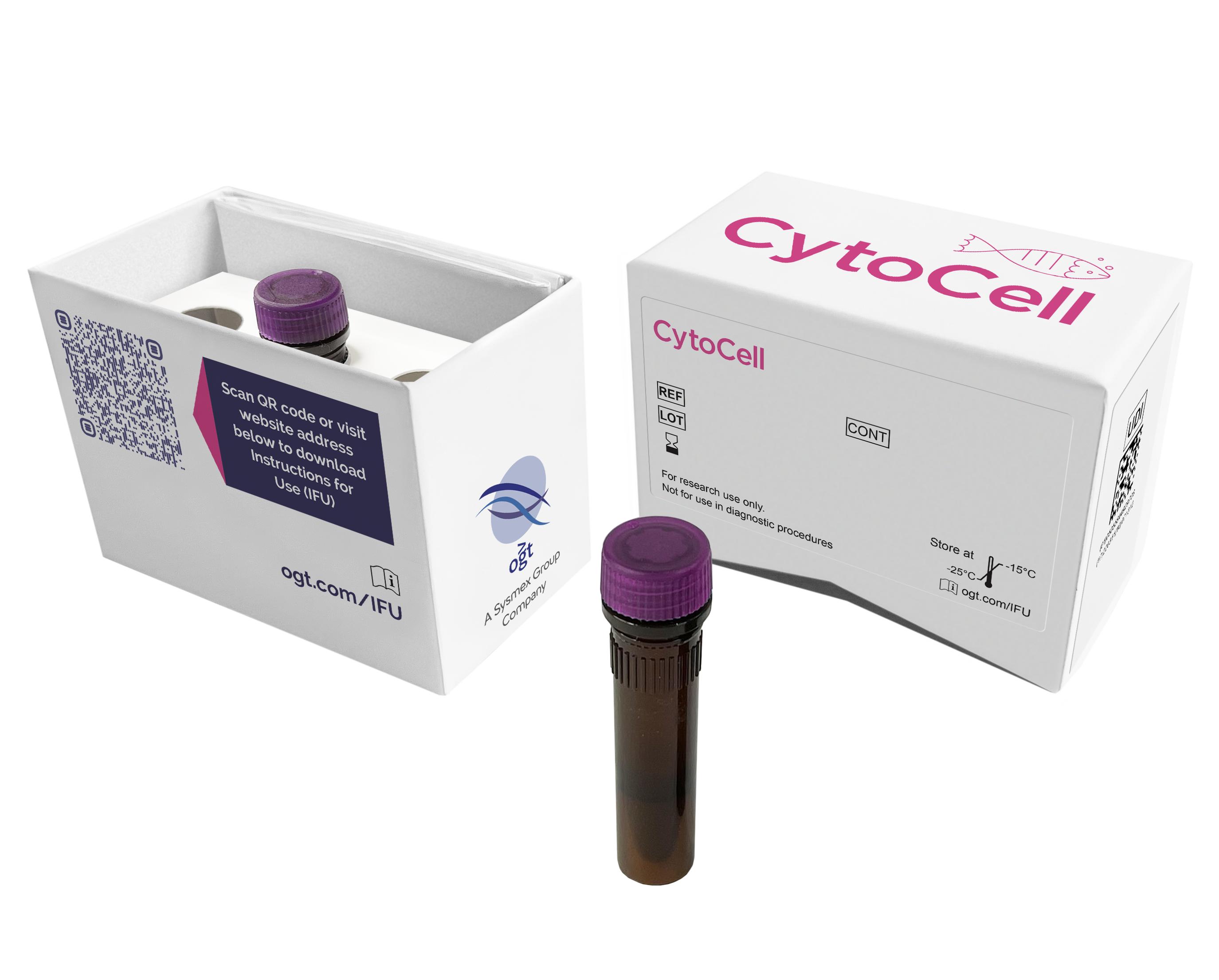
The TLX3 product consists of a 162kb probe, labelled in red, located centromeric to the TLX3 gene, including the middle part of the RANBP17 gene and the D5S653 marker and a green probe covering a 173kb region located telomeric to the gene, including the NPM1 and FGF18 genes and the RH80894 marker.
The TLX3 (T-cell leukemia homeobox 3) gene at 5q35 can be aberrantly expressed in T-cell acute lymphoblastic leukaemia (T- ALL) due to a cryptic translocation1.
Unlike TLX1, the dysregulation of TLX3 is not brought about by close juxtaposition with T-cell receptor genes, instead, it is brought into contact with another gene that is highly expressed in normal T-cell differentiation: BCL11B at 14q322. The t(5;14)(q35;q32) translocation is cryptic and the breakpoint does not actually disrupt TLX3 but, in the majority of cases, occurs within or downstream of the RANBP17 gene3. RANBP17 is very close to TLX3 and although its expression is not affected by the translocation, TLX3 expression is affected. The t(5;14)(q35;q32) translocation is found in approximately 20% of childhood T-ALL and 13% of adult cases. Rarer TLX3 rearrangements have also been reported: a t(5;7)(q35;q21) translocation involving CDK6 at 7q21 and a t(5;14)(q35;q11) translocation involving TRA/D at 14q11.21.
Find certificate of analysis documentation for our CytoCell FISH probes

Our lab has been using a wide range of CytoCell FISH probes for a number of years, and have been increasing this range all the time. The probes have clear bright signals and show good reproducibility. CytoCell provides fast delivery of catalogue probes, and are very responsive when we have any queries or problems with their products.

Bridget Manasse
Addenbrookes Hospital, Cambridge University Hosiptals NHS Foundation Trust, UK
In our hands, CytoCell FISH probes have proven to be of the highest quality with bright, easy to interpret signals, thus providing confidence in our results. OGT's customer support is outstanding, as their staff are extremely knowledgeable and truly care about their customers and their customers’ needs.

Jennie Thurston
Director of Cytogenetics, Carolinas Pathology Group, USA
I first came across CytoCell FISH probes in a previous lab I worked in and I was struck by the quality of the products. Since this time, I have been recommending and introducing CytoCell probes across all application areas — now they are the primary FISH probes used in our lab. They have an excellent range of products and their ready-to-use reagent format saves considerable time.

Elizabeth Benner
Medical Technologist, University of Arizona Health Network, USA
We have been working with CytoCell fish probes for two decades because of their excellent clarity and intensity regardless of the size of the probe. It is so clear and simple to detect.
Dr. Marina Djurisic
Head of Laboratory of Medical Genetics, Mother and Child Health Care Institute of Serbia “Dr Vukan Cupic”, Serbia
The quality and consistency of CytoCell’s probes means I can trust the results, and my clients get their results in a timely manner.

Dr. Theresa C. Brown
Director, Cytogenetics Laboratory, Hayward Genetics Center, Tulane University School of Medicine, USA
It was very important for us to have more consistent results with our probes — easy-to-read bright signals and a range of vial sizes, which is much more cost-effective.

Janet Cowan, PhD
Director of the Cytogenetics Laboratory, Tufts Medical Center, USA
Not only do CytoCell offer an extensive range of high-quality FISH probes, the customer support is also excellent — providing fast access to all the probes I need. The probes are highly consistent with bright signals allowing easy scoring of results.
Dr. Eric Crawford
Senior Director, Genetics Associates Inc., USA
The quality and reproducibility of results using the CytoCell kit has been vital in accurately detecting co-deletions in our glioma investigations. We now have a cost-effective test that we can rely on that is also easy to use and interpret. We've been consistently impressed with this kit - not to mention the support offered by OGT's customer service, and have completely transitioned over to CytoCell probes.
Gavin Cuthbert, FRCPath
Head of Cancer Cytogenetics, Northern Genetics Servce, Newcastle, UK